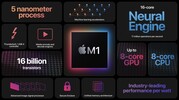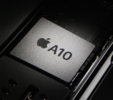Apple M1 vs Apple A10X Fusion vs Apple A10 Fusion
Apple M1
► remove from comparison
The Apple M1 is a System on a Chip (SoC) from Apple that is found in the late 2020 MacBook Air, MacBook Pro 13, and Mac Mini. It offers 8 cores divided in four performance cores and four power-efficiency cores. The big cores offer 192 KB instruction cache, 128 KB data cache, and 12 MB shared L2 cache. According to Apple the performance of these cores should be better than anything on the market (in late 2020). The four efficiency cores are a lot smaller and offer only 128 KB instruction cache, 64 KB data cache, and 4 MB shared cache. The efficiency cores (E cluster) clock with 600 - 2064 MHz, the performance cores (P cluster) with 600 - 3204 MHz.
The M1 is available in two TDP variants, a passive cooled 10 Watt variant for the MacBook Air and an active cooled faster variant for the MacBook Pro 13 and Mac Mini. Those should offer a better-sustained performance according to Apple.
The integrated graphics card in the M1 offers 8 cores (7 cores in the entry MacBook Air) and a peak performance of 2.6 teraflops. Apple claims that it is faster than any other iGPU at the time of announcement.
Furthermore, the SoC integrates a fast 16 core neural engine with a peak performance of 11 TOPS (for AI hardware acceleration), a secure enclave (e.g., for encryption), a unified memory architecture, Thunderbolt / USB 4 controller, an ISP, and media de- and encoders.
The Apple M1 includes 16 billion transistors (up from the 10 billion of the A12Z Bionic and therefore double the amount of a Tiger Lake-U chip like the i7-1185G7) and is manufactured in 5nm at TSMC.
Apple A10X Fusion
► remove from comparisonThe Apple A10X Fusion is a system on a chip (SoC) from Apple that is built into the 2017 iPad Pro models. It integrates six 64 Bit cores that are divided in two clusters. Three high performance cores are clocked at up to 2.39 GHz. The three power saving cores are used for non demanding tasks. It looks like only one of both clusters is able to run at a time (therefore the apps see only three cores). The principle is similar to the first generation of ARMs big.LITTLE concept.
The performance of the SoC is positioned in the high and and clearly faster than all previous Apple SoCs. Even compared to Android high-end SoCs like the Snapdragon 835, the A10X takes the lead (e.g. in Geekbench or Antutu).
The integrated graphics card of the SoC will most likely stem from PowerVR (again) and features 12 cores instead of 6 in the A10 SoC.
According to TechInsights, the A10X is manufactured in the brand new 10 nm FinFet process at TSMC. Altough it offers more function blocks, the A10X is with measured 96.4 mm2 significantly smaller than the previous A9X (143.9 mm2).
Apple A10 Fusion
► remove from comparison
The Apple A10 Fusion is a system on a chip (SoC) from Apple that is built into the iPhone 7 and iPhone 7 Plus. It integrates four 64 Bit cores that are divided in two clusters. Two high performance cores are clocked at up to 2.34 GHz and should be around 40% faster than the Apple A9 (according to Apple) and two low power cores (up to 1.1 GHz?). Up to now its unclear if all four cores can be used at once (that need only 1/5 th of the energy in some use cases). At the release of the iPhone 7 it looks like that IOS is only using two cores at a time and automatically switches between the two clusters. Therefore, apps are seeing only a dual core. The principle is similar to the first generation of ARMs big.LITTLE concept.
The integrated graphics card of the SoC will most likely stem from PowerVR (again) and perform 50% faster at 2/3 of the power consumption (according to Apple).
All in all the chip includes 3.3 billion transistors, which is more than a current AMD Bristol Ridge (3.1) and Skylake Quad-Core (1.75) X86 SoCs.
Sources: Apple Keynote, Ars Technica
| Model | Apple M1 | Apple A10X Fusion | Apple A10 Fusion | ||||||||||||||||
| Series | Apple M1 | Apple Apple A-Series | Apple Apple A-Series | ||||||||||||||||
| Series: M1 |
| ||||||||||||||||||
| Clock | 2064 - 3220 MHz | 2390 MHz | 2340 MHz | ||||||||||||||||
| L1 Cache | 2 MB | ||||||||||||||||||
| L2 Cache | 16 MB | ||||||||||||||||||
| L3 Cache | 8 MB | ||||||||||||||||||
| Cores / Threads | 8 / 8 | 6 / 3 | 4 / 2 | ||||||||||||||||
| Transistors | 16000 Million | 3300 Million | 3300 Million | ||||||||||||||||
| Technology | 5 nm | 10 nm | 16 nm | ||||||||||||||||
| Features | ARMv8 Instruction Set | ARMv8 Instruction Set | ARMv8 Instruction Set | ||||||||||||||||
| iGPU | Apple M1 8-Core GPU | Apple A10X Fusion GPU / PowerVR | Apple A10 Fusion GPU / PowerVR (900 MHz) | ||||||||||||||||
| Architecture | ARM | ARM | ARM | ||||||||||||||||
| Announced | |||||||||||||||||||
| Codename | Cyclone 4? | APL1021 Hurricane / Zephyr |
Benchmarks
Average Benchmarks Apple M1 → 100% n=8
Average Benchmarks Apple A10X Fusion → 51% n=8
Average Benchmarks Apple A10 Fusion → 38% n=8
* Smaller numbers mean a higher performance
1 This benchmark is not used for the average calculation












